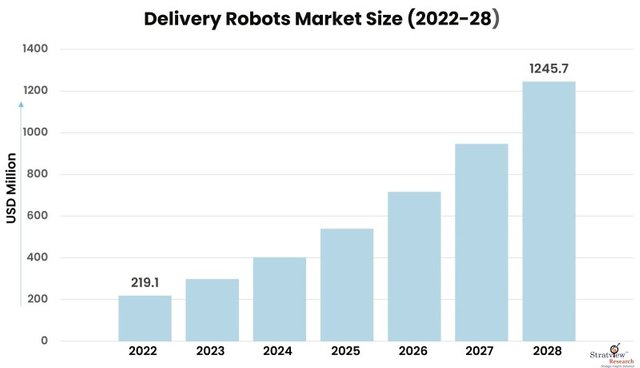The delivery robots market is rapidly evolving as businesses increasingly turn to automation to meet the growing demand for efficient last-mile delivery solutions. As the market expands, companies are exploring various strategies to gain a competitive edge and capitalize on emerging opportunities. This article delves into the key growth strategies and insights shaping the delivery robots market.
According to Stratview Research, the delivery robots market was estimated at USD 219.1 million in 2022 and is likely to grow at a CAGR of 33.12% during 2023-2028 to reach USD 1,245.7 million in 2028.

1. Investing in Advanced Technology and AI Integration
One of the most significant growth strategies in the delivery robots market is the continuous investment in advanced technologies such as Artificial Intelligence (AI), Machine Learning (ML), and computer vision. These technologies enhance the capabilities of delivery robots, enabling them to navigate complex environments, avoid obstacles, and make autonomous decisions in real-time. By integrating AI-driven route optimization and obstacle detection, companies can improve delivery efficiency and reduce operational costs. Keeping up with technological advancements ensures that businesses remain competitive in a rapidly evolving market.
2. Strategic Partnerships and Collaborations
Forming strategic partnerships and collaborations is another key strategy for growth in the delivery robots market. Companies are partnering with technology providers, logistics firms, and retail giants to expand their market reach and enhance their service offerings. For instance, collaborations between robot manufacturers and e-commerce platforms allow businesses to tap into existing distribution networks and customer bases, accelerating the deployment of delivery robots. Such partnerships enable companies to leverage each other’s strengths, driving innovation and market penetration.
3. Expanding Application Areas Beyond E-commerce
While e-commerce remains a significant driver, companies are increasingly exploring new application areas for delivery robots, such as food delivery, healthcare, and hospitality. Expanding into these sectors allows businesses to diversify their revenue streams and mitigate the risks associated with relying on a single market. For example, delivery robots are being used in hospitals to transport medical supplies and in hotels to provide room service, showcasing the versatility of these autonomous solutions. This strategic diversification helps companies capture a broader customer base and drive sustained growth.
4. Enhancing Customer Experience and Service Quality
Focusing on customer experience is crucial for success in the delivery robots market. Companies are prioritizing user-friendly interfaces, real-time tracking, and seamless delivery experiences to meet rising consumer expectations. By incorporating feedback mechanisms and continuously improving service quality, businesses can build strong customer loyalty and differentiate themselves in a competitive landscape. Personalization features, such as tailored delivery schedules and notifications, further enhance the user experience, fostering positive brand perception.
5. Regulatory Compliance and Safety Enhancements
Navigating the complex regulatory environment is essential for growth in the delivery robots market. Ensuring compliance with local regulations, such as those governing pedestrian pathways and safety standards, is critical for successful deployment. Companies are investing in safety features, including advanced sensors and emergency stop functions, to comply with regulatory requirements and enhance public acceptance of delivery robots. Proactive engagement with regulatory bodies and communities helps companies address concerns and pave the way for wider adoption.
Conclusion
The delivery robots market offers immense growth potential, driven by technological advancements, strategic collaborations, and expanding application areas. By focusing on customer experience, safety, and regulatory compliance, companies can navigate the market effectively and position themselves for long-term success. As businesses continue to innovate and adapt, the delivery robots market will play a pivotal role in shaping the future of last-mile logistics.